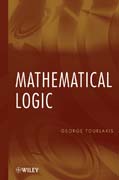
INDICE: Preface. Acknowledgments. PART I: BOOLEAN LOGIC. 1. The Beginning. 1.1 Boolean Formulae. 1.2 Induction on the Complexity of WFF Some Easy Properties of WFF. 1.3 Inductive definitions on formulae. 1.4 Proofs and Theorems. 1.5 Additional Exercises. 2. Theorems and Metatheorems. 2.1 More Hilbertstyle Proofs. 2.2 Equationalstyle Proofs. 2.3 Equational Proof Layout. 2.4 More Proofs; Enriching our Toolbox. 2.5 Using Special Axioms in Equational Proofs. 2.6 The Deduction Theorem. 2.7 Additional Exercises. 3. The Interplay between Syntaxand Semantics. 3.1 Soundness. 3.2 Posts Theorem. 3.3 Full Circle. 3.4 SingleFormula Leibniz. 3.5 Appendix: Resolution in Boolean Logic. 3.6 Additional Exercises. PART II: PREDICATE LOGIC. 4. Extending Boolean Logic. 4.1 The First Order Language of Predicate Logic. 4.2 Axioms and Rules of First Order Logic. 4.3Additional Exercises. 5 Two Equivalent Logics. 6. Generalisation and Additional Leibniz Rules. 6.1 Inserting and Removing ‘(8x)’. 6.2 Leibniz Rules that Affect Quantifier Scopes. 6.3 The Leibniz Rules ‘8.12’. 6.4 More Useful Tools. 6.5 Inserting and Removing ‘(9x)’. 6.6 Additional Exercises. 7. Properties of Equality. 8. First Order Semantics -- Very Naïvely. 8.1 Interpretations. 8.2 Soundness in Predicate Logic. 8.3 Additional Exercises. Appendix A: Göodel Completeness and Incompleteness; Introduction to Computability. A.1 Revisiting Tarski Semantics. A.2 Completeness. A.3 A Brief Theory of Computability. A.3.1 A Programming Framework for Computable Functions. A.3.2 Primitive Recursive Functions. A.3.3 URM Computations. A.3.4 SemiComputable Relations; Unsolvability. A.4 Godel's First Incompleteness Theorem. A.4.1 Supplement: _x(x) ‘ is first order definable in N. Index. References 381. Mathematical logic is the art and science of mathematical reasoning. The only book written for the undergraduatelogic user that is rigorous, correct, and user-friendly, Mathematical Logic presents mathematical or ‘symbolic’ logic as a reliable tool for deductive reasoning in computer science, mathematics, philosophy, and other related disciplines. The book trains the reader in both the established ‘Hilbert’ style as well as in the emerging ‘equational’ style, enabling students in computer scienceand mathematics to become proficient users of logic. The intention is to serve computer science and mathematics majors predominantly in an upper year of undergraduate study; large segments of the text, notably all of Part I and selected portions of Part II, may be appropriate for some philosophy courses; reference appeal in departmental and public/private university libraries
- ISBN: 978-0-470-28074-4
- Editorial: John Wiley & Sons
- Encuadernacion: Cartoné
- Páginas: 312
- Fecha Publicación: 05/09/2008
- Nº Volúmenes: 1
- Idioma: Inglés
